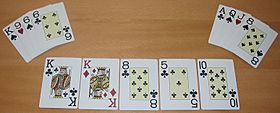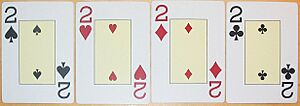Omaha hold 'em facts for kids
Omaha hold 'em (also known as Omaha) is a fun poker game. It's a lot like Texas hold 'em, but with a cool twist! In Omaha, each player gets four cards instead of two. The main rule is you must use exactly two of your own cards and exactly three of the five shared cards on the table to make your best hand.
The game uses a standard 52-card deck. It's believed that a casino boss named Robert Turner first brought Omaha to a casino. He showed it to Bill Boyd, who then offered it at the Golden Nugget Casino in Las Vegas. They called it "Nugget Hold'em" back then.
Contents
History of Omaha Poker
Omaha hold 'em gets its name from two parts: "Hold'em" and "Omaha."
What "Hold'em" Means
"Hold'em" means it's a game where players share cards. These shared cards are called "community cards." This is different from games where players only have their own secret cards. It's also different from "stud" games, where some of your cards are hidden and some are showing.
What "Omaha" Means
The "Omaha" part of the name is important. It means you *must* use exactly two of your own cards. In the very first Omaha game, players only got two cards. But even now, with four cards, you still have to pick just two to combine with the community cards. This rule is what makes Omaha unique!
How Omaha Works
In North America, "Omaha" can mean a few different poker games. The most common one is "Omaha high." There's also "Omaha Hi-Lo," which we'll explain later. In Europe, "Omaha" usually means the "high" version. It's often played as "pot-limit," which means you can bet up to the size of the pot.
Understanding "The Nuts"
People often say Omaha is a game of "the nuts." This means you usually need the very best possible hand to win. Because players have four cards, there are many more ways to make strong hands. Sometimes, even experienced players need time to figure out their best hand!
Key Differences from Texas Hold 'em
Here are the main ways Omaha is different from Texas hold 'em:
- You get four cards in your hand, not two.
- The betting rounds and how the community cards are dealt are the same.
- When it's time to show your cards (the "showdown"), you must use *exactly three* of the five community cards.
- You must also use *exactly two* of your own four cards.
- You cannot use more or less than two of your own cards. For example, you can't use only one of your cards and four from the board.
Up to eleven players can play a hand of Omaha. It's most often played with six or nine players.
Important Rules for Omaha Hands
Here are some special things to remember when playing Omaha:
- Making a Flush: If there are three or more cards of the same suit on the board, a flush is possible. But you *always* need two cards of that suit in your hand to make a flush. For example, if the board has three spades, you need two spades in your hand to make a spade flush. You can't use just one spade from your hand like you might in Texas hold 'em.
- Making a Straight: You cannot use just one card from your hand and four from the board to make a straight. You need two cards from your hand and three from the board.
- Full Houses with Pairs on the Board: If there are two pairs on the board (like two Jacks and two Nines), you can't make a full house with just one matching card in your hand. You need a pair in your hand to make a full house. For example, if the board is J-J-9-5-9, and you have a Jack and another card, you can't make a full house. You need two Jacks or two Nines in your hand to make a full house.
- Full Houses with Three of a Kind on the Board: If there are three of a kind on the board (like three Jacks), you need a pair in your hand to make a full house. If you only have one matching card, you just have three of a kind with a kicker, which might not win.
Omaha Hi-Lo Split-8 or Better
In Omaha hi-low split-8 or better (often called Omaha/8), the pot is split! Players try to make two different hands:
- A five-card high hand.
- A five-card low hand.
To make a low hand, your hand must be "eight-high or lower." This means your five cards must all be 8 or below (Aces count as low). If no one can make a qualifying low hand, the high hand wins the whole pot.
Just like in regular Omaha, you must use exactly two of your four hole cards for your high hand. And you must use exactly two *different* hole cards for your low hand. Sometimes, the same player can win both the high and low parts of the pot! This is called "scooping."
Important Notes for Omaha/8 Hands
- Low Hand Qualification: For a low hand to be possible, there must be at least three different cards that are 8 or lower on the board.
- Tied Low Hands: Low hands often tie, meaning players share the low part of the pot. Winning a quarter of the pot is common and is called "getting quartered."
- "Counterfeiting": This is a tricky part of Omaha/8. If you have a great low hand, like A-2, and the board is A-6-7, you have the "nut low" (the best possible low). But if a 2 or 3 comes on the next card, your hand might be "counterfeited." This means your hand is no longer the best low, because another player might now have a better one.
- Reading Low Hands: When many low cards are on the board, it can be hard to figure out the best low hand. Remember, straights and flushes don't count when judging low hands. The best low hand is 5-4-3-2-A (called "the wheel").
Best and Worst Starting Hands
- Worst Hands: Having three or four cards of the same rank (like four 2s) is very bad in Omaha. You can only use two cards from your hand, so four of a kind is useless. Also, starting with four cards of the same suit makes it harder to make a flush, because you need two of that suit from your hand.
- Best Hands: Computer studies show that the best starting hand for Omaha high is A-A-K-K (especially if two suits are repeated, called "double suited"). For Omaha Hi-Lo, the best starting hand is A-A-2-3 (also double suited). These hands give you many chances to make strong high and low hands.
Pot-Limit Omaha (PLO)
Pot-limit Omaha (often called PLO) is very popular online and in Europe. In PLO, you can bet as much as the current size of the pot. This game is often played "high only," meaning there's no split pot for a low hand.
In PLO, it's even more important to aim for "the nuts" (the best possible hand). If you have the second-best flush or straight, you can lose a lot of money. This is because the pot can grow very quickly in pot-limit games.
What are "Wraps"?
In poker, an "out" is a card that will make your hand better. A "wrap" is a special type of straight draw in Omaha. It means you have nine or more "outs" to make a straight. This happens because your four hole cards can "wrap around" the cards on the board, giving you many ways to complete a straight. For example, you could have a hand that can make a straight if a 5, 6, 7, 10, Jack, or Queen appears!
What are "Redraws"?
A "redraw" is when you have the best hand right now, but you also have a chance to make an even better hand later. For example, if you have the best straight, but also a pair in your hand that could make a full house if the board pairs up, that's a redraw. Having redraws makes your hand much stronger and safer!
Omaha Variations
Besides the main Omaha games, there are other versions:
- Five-card Omaha (also called "Big O" or "5-O") is popular in some places.
- Six-card Omaha (or "6-O") is played in many casinos, especially in the UK.
- Some online poker sites offer these variations.
Courchevel
Courchevel is another variation of Omaha. It's named after a ski resort in France. In Courchevel, players get five hole cards instead of four. Also, the first community card is dealt at the very beginning, before the first betting round. After that, two more community cards are dealt to make a three-card "flop." The rest of the game is like regular Omaha, where you still must use exactly two of your five hole cards. Courchevel is popular in France and other parts of Europe.
See also
 In Spanish: Omaha hold 'em para niños
In Spanish: Omaha hold 'em para niños
- Glossary of poker terms
- List of poker hands
- Texas hold'em
- Greek hold 'em





